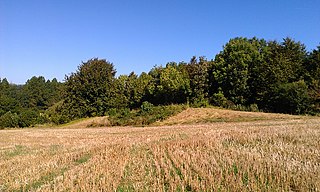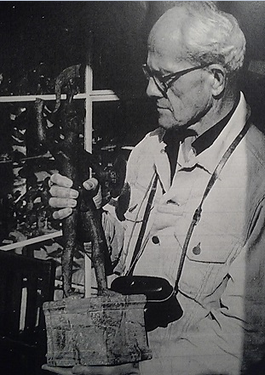The Kent Archaeological Society was founded in 1857 to promote the study and publication of archaeology and history, specifically that pertaining to the ancient county of Kent in England. This includes the modern administrative county as well as areas now subsumed by south east London and in the district of Medway.
It carries out archaeological surveys and excavations funded through membership subscriptions as well as being involved in the protection and recording of historic buildings and churches. In addition, it organises lectures, excursions and other education projects and can make grants or loans of equipment to archaeological projects. A library in the museum at Maidstone is available for members' use and a field school, the Kent Archaeological Field School, is often run in the summer.
The society publishes an annual journal, Archaeologia Cantiana, and a quarterly newsletter. Through its Record Series, it publishes editions of archival texts relating to the county, and it therefore functions as the record society for Kent. It publishes other occasional volumes on specific topics.
Recent projects have included assisting in the excavation of the Ringlemere barrow and an edition and translation of the Kent Hundred Rolls. A number of local societies are affiliated to it and it has links with national and county archaeological organisations.
The Sussex Archaeological Society is an organisation dedicated to researching and preserving the history and archaeology of the English counties of East Sussex and West Sussex. It manages six historic sites, including Lewes Castle and Fishbourne Roman Palace.

Jens Jacob Asmussen Worsaae was a Danish archaeologist, historian and politician, who was the second director of the National Museum of Denmark (1865–1874). He played a key role in the foundation of scientific archaeology. Worsaae was the first to excavate and use stratigraphy to prove C. J. Thomsen's sequence of the Three-age system: Stone, Bronze, Iron. He was also a pioneer in the development of paleobotany through his excavation work in the peat bogs of Jutland. Worsaae served as Kultus Minister of Denmark for Christen Andreas Fonnesbech from 1874 to 1875.

Prehistoric archaeology is a subfield of archaeology, which deals specifically with artefacts, civilisations and other materials from societies that existed before any form of writing system or historical record. Often the field focuses on ages such as the Stone Age, Bronze Age and Iron Age, although it also encompasses periods such as the Neolithic. The study of prehistoric archaeology reflects the cultural concerns of modern society by showing interpretations of time between economic growth and political stability. It is related to other disciplines such as geology, biology, anthropology, historiography and palaeontology, although there are noticeable differences between the subjects they all broadly study to understand; the past, either organic or inorganic or the lives of humans. Prehistoric archaeology is also sometimes termed as anthropological archaeology because of its indirect traces with complex patterns.

The Coldrum Long Barrow, also known as the Coldrum Stones and the Adscombe Stones, is a chambered long barrow located near the village of Trottiscliffe in the south-eastern English county of Kent. Probably constructed in the fourth millennium BCE, during Britain's Early Neolithic period, today it survives only in a state of ruin.

The Medway Megaliths, sometimes termed the Kentish Megaliths, are a group of Early Neolithic chambered long barrows and other megalithic monuments located in the lower valley of the River Medway in Kent, South-East England. Constructed from local sarsen stone and soil between the 4th and 3rd millennia BCE, they represent the only known prehistoric megalithic group in eastern England and the most south-easterly group in Britain.

Smythe's Megalith, also known as the Warren Farm Chamber, was a chambered long barrow near the village of Aylesford in the south-eastern English county of Kent. Probably constructed in the 4th millennium BCE, during Britain's Early Neolithic period, it was discovered in 1822, at which point it was dismantled. Built out of earth and at least five local sarsen megaliths, the long barrow consisted of a roughly rectangular earthen tumulus with a stone chamber in its eastern end. Human remains were deposited into this chamber.

Addington Long Barrow is a chambered long barrow located near the village of Addington in the southeastern English county of Kent. Probably constructed in the fourth millennium BCE, during Britain's Early Neolithic period, today it survives only in a ruined state. Built of earth and about fifty local sarsen megaliths, the long barrow consisted of a sub-rectangular earthen tumulus enclosed by kerb-stones. Collapsed stones on the northeastern end of the chamber probably once formed a stone chamber in which human remains might have been deposited, though none have been discovered.
Archaeology is the study of human activity in the past, primarily through the recovery and analysis of the material culture and environmental data that they have left behind, which includes artifacts, architecture, biofacts and cultural landscapes.


Julliberrie's Grave, also known as The Giant's Grave or The Grave, is an unchambered long barrow located near to the village of Chilham in the south-eastern English county of Kent. Probably constructed in the fourth millennium BCE, during Britain's Early Neolithic period, today it survives only in a state of ruin.

Glenn Albert Black was an American archaeologist, author, and part-time university lecturer who was among the first professional archaeologists to study prehistoric sites in Indiana continuously. Black, a pioneer and innovator in developing archaeology field research techniques, is best known for his excavation of Angel Mounds, a Mississippian community near present-day Evansville, Indiana, that he brought to national attention. Angel Mounds was designated a National Historic Landmark in 1964. Black was largely self-taught and began serious work on archaeological sites in Indiana in the 1930s, before there were many training opportunities in archaeology in the United States. He is considered to have been the first full-time professional archaeologist focusing on Indiana's ancient history, and the only professional archaeologist in the state until the 1960s. During his thirty-five-year career as an archaeologist in Indiana, Black also worked as a part-time lecturer at Indiana University Bloomington from 1944 to 1960 and conducted a field school at the Angel site during the summer months.

Charles Roach Smith, FSA, was an English antiquarian and amateur archaeologist who was elected a fellow of the Society of Antiquaries of London, and the London Numismatic Society. He was a founding member of the British Archaeological Association. Roach Smith pioneered the statistical study of Roman coin hoards.
The decade of the 1750s in archaeology involved some significant events.

Archaeology or archeology is the study of human activity through the recovery and analysis of material culture. The archaeological record consists of artifacts, architecture, biofacts or ecofacts, sites, and cultural landscapes. Archaeology can be considered both a social science and a branch of the humanities. It is usually considered an independent academic discipline, but may also be classified as part of anthropology, history or geography.
Polhill Anglo-Saxon cemetery is a place of burial that was used in the seventh and eighth centuries CE. It is located close to the hamlet of Polhill, near Sevenoaks in Kent, South-East England. Belonging to the Middle Anglo-Saxon period, it was part of the much wider tradition of burial in Early Anglo-Saxon England.
Finglesham Anglo-Saxon cemetery is a place of burial that was used from the sixth to the eighth centuries CE. It is located adjacent to the village of Finglesham, near Sandwich in Kent, South East England. Belonging to the Anglo-Saxon period, it was part of the much wider tradition of burial in Early Anglo-Saxon England.

Sarre Anglo-Saxon cemetery is a place of burial that was used in the sixth and seventh centuries CE.

Leslie Valentine Grinsell was an English archaeologist and museum curator. Publishing over twenty books on archaeology during his lifetime, he was renowned as a specialist on the prehistoric barrows of southern England.

Margaret Ursula Jones was an English archaeologist, best known for directing major excavations at Mucking, Essex.
Denis Grant King was an archaeological draftsman, artist, historic monument conservation campaigner and archaeologist. He worked predominantly in Wiltshire, England, most notably as Alexander Keiller’s surveyor and draftsman during the excavations at Avebury.